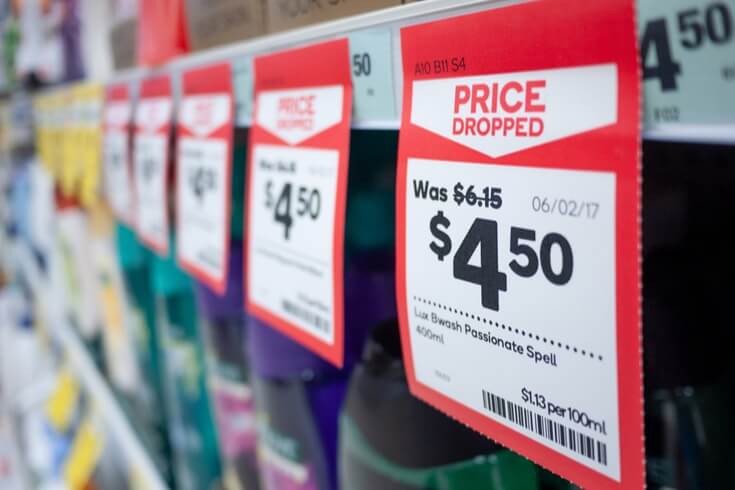What is Double Pricing? Explaining Points to Avoid Violating the 'Japanese Premiums and Representations Act' and Penalties

“Half off the regular price!” Such price displays, which emphasize the low selling price to consumers by comparing it with other prices, are commonly used. However, depending on the circumstances, such dual pricing displays may be subject to penalties as unfair displays under the Japanese Premiums and Representations Act.
However, it is actually a difficult issue to determine what kind of price display is a dual price display, and in what cases it constitutes an unfair display that violates the Japanese Premiums and Representations Act.
In this article, we will explain the relationship between the Japanese Premiums and Representations Act and dual pricing displays, and points to be careful about in order not to violate the Japanese Premiums and Representations Act.
What is the Japanese Premiums and Representations Act?
The Japanese Premiums and Representations Act is a law designed to prevent businesses from attracting customers through unfair means and to protect the interests of general consumers.
To achieve this, the Japanese Premiums and Representations Act regulates the following actions:
- Display of the quality, content, price, etc. of goods or services (Prohibition of Unfair Display)
- Provision of premiums (Restrictions and Prohibition of Premiums)
In this article, we will only explain the ‘Prohibition of Unfair Display’ in relation to dual pricing. For regulations regarding premiums, please refer to the following article as well.
Related article: What is the relationship between e-sports tournaments and the Japanese Premiums and Representations Act? Points to note for tournament organizers
The main prohibitions as unfair displays are the following two:
- Superiority Misrepresentation
- Advantage Misrepresentation
‘Superiority Misrepresentation’ refers to a display that shows to general consumers that the content of the goods or services you provide is ‘significantly superior’ to the actual ones or those of other competing businesses.
On the other hand, ‘Advantage Misrepresentation’ refers to a display that makes general consumers misunderstand that the trading conditions of the goods or services you provide are ‘significantly advantageous’ compared to the actual ones or those of other competing businesses.
In other words, the Japanese Premiums and Representations Act does not prohibit dual pricing itself, but prohibits dual pricing that falls under the above-mentioned unfair displays (especially Advantage Misrepresentation).
Related article: How far is it OK for products on the Internet? Explanation of regulations by the Japanese Premiums and Representations Act
What is Dual Pricing?

According to the Price Display Guidelines of the Japanese Consumer Affairs Agency,
Dual pricing is when a business displays its own selling price alongside another price that is higher than the selling price (hereinafter referred to as the “comparison price”).
For example, if the price is displayed as “Normally priced at 2,000 yen in our store, now 30% off sale price at 1,400 yen”, the selling price is the sale price of 1,400 yen, and the comparison price is the normal price of 2,000 yen.
Dual pricing, if displayed correctly, can actually help consumers choose products. Moreover, achieving lower prices than competitors is a result of corporate efforts, and prohibiting this could potentially go against the principle of competition.
Therefore, the Price Display Guidelines point out that the following types of dual pricing may be considered unfair display:
- Displaying the price of a different product as the comparison price
- Displaying a comparison price that is different from the actual price or is ambiguous, even for the same product
The identity of a product is mainly determined by its brand, quality, and specifications. However, just because the comparison is between different products does not mean it is immediately considered an unfair display. However, when displaying the price of a different product as the comparison price, it is desirable to clearly state the differences in quality, etc., to avoid misleading consumers.
On the other hand, even for the same product, there can be various types of comparison prices, so it is necessary to consider whether the display is unfair depending on the type of comparison price.
The following are mainly used as comparison prices:
- Dual pricing using past selling prices as the comparison price
- Dual pricing using future selling prices as the comparison price
- Dual pricing using the suggested retail price as the comparison price
- Dual pricing using the selling price of a competitor as the comparison price
In this article, we will mainly explain about dual pricing using “past selling prices”, which is particularly common.
You often see displays that emphasize the low selling price during the sale period by showing past selling prices such as “our store’s regular price” or “pre-sale price” in limited-time sales. For example, the display “Normally priced at 2,000 yen in our store, now 30% off sale price at 1,400 yen” falls into this category.
As mentioned above, if there is a real sale, it is beneficial for consumers and there is no reason to prohibit it.
However, for example, if the implementation of the sale and the sale price were decided in advance at the time of the start of the sale of the sale target product, the pre-sale may be considered a temporary performance to emphasize the cheapness of the sale, which may mislead the general consumer to believe that the selling price during the sale is cheap.
Therefore, the Price Display Guidelines determine whether the display is unfair based on whether the comparison price was “a price that has been sold for a recent considerable period of time”.
Specifically, if all of the following requirements are met, it is considered as “a price that has been sold for a recent considerable period of time”, and it is not considered an unfair display:
- Sold at the comparison price for more than half of the period looking back 8 weeks (or the said period if less than 8 weeks) from the start of the sale (also known as the “8-week rule”)
- The period during which it was sold at the comparison price is a total of 2 weeks or more
- Within 2 weeks from the last day it was sold at the comparison price at the start of the sale
Specific Examples of Dual Pricing and Other Unfair Displays

Let’s consider the display “Our regular price is 2,000 yen, but it’s now on sale for 30% off at 1,400 yen” as a specific example.
When the price used for comparison is displayed differently or ambiguously from the actual price
For example, the actual regular price was 1,800 yen.
When there is no sales record at the comparison price
For example, the product is being sold for the first time, or it has been sold in the past, but it has never been sold for 2,000 yen.
When the sales period at the comparison price is short
For example, during the past sales period (8 weeks), the product was sold for 2,000 yen only for the first 3 weeks, and for the remaining 5 weeks, it was sold for 1,800 yen.
When the comparison price is a sales price from more than 2 weeks ago
For example, the last time the product was sold for 2,000 yen was half a year ago.
When the price of a different product is used as the comparison price
For example, displaying the regular price of 2,000 yen for a new product identical to the one in question as the comparison price, even though the product has been used as a display item for a long period and is not considered new.
About Other Types of Dual Pricing Display
While the above is based on the assumption of comparing with “past sales prices”, it is also advisable to pay attention to the following points when comparing with “future sales prices” and the like.
- Unless it is confirmed that the product will be sold at the said price in the future, regardless of supply and demand conditions, do not display dual pricing by comparing with future sales prices (such as “trial prices”). Check whether the sales at the trial price continue even after the “trial period” and the like have ended.
- When comparing with the suggested retail price of the manufacturer and the like, check whether the said price is publicly available in the manufacturer’s catalogues, pamphlets, etc. (It does not include cases where individual inquiries are necessary.)
- When comparing with the market price or the sales price of a specific competitor, accurately investigate the recent sales price of the competitor, and in the case of a specific competitor, also clearly state the name of the business operator.
We recommend referring to the Price Display Guidelines for these specific examples.
Penalties for Illegal Dual Pricing
If dual pricing is deemed as an unfair representation, penalties may be imposed, including an order for measures and a surcharge payment order.
Order for Measures
An “Order for Measures” refers to the Consumer Affairs Agency ordering businesses to take mainly the following actions:
- Elimination of misunderstandings caused to general consumers by unfair representation
- Implementation of measures to prevent recurrence
- Not to commit similar violations in the future
Surcharge Payment Order
Also, a “Surcharge Payment Order” is an order for the business that committed the act to pay up to three years’ worth of an amount calculated by multiplying 3% of the sales of goods or services gained through unfair representation. If the act has been carried out over a long period, the surcharge can be substantial.
However, depending on the case, there may be instances where a surcharge payment order is not issued or the surcharge is reduced.
- When the business has taken the necessary care in accordance with normal business practices, such as verifying the information that forms the basis of the display, and is not deemed to have neglected due care
- When the calculated surcharge is less than 1.5 million yen, i.e., when the total amount of goods or services sold by the act subject to the surcharge is less than 50 million yen
- When the facts corresponding to the act subject to the surcharge are voluntarily reported to the Commissioner of the Consumer Affairs Agency
- When a refund measure has been taken for consumers in accordance with the prescribed procedures, such as creating a plan for implementing refund measures and receiving approval from the Commissioner of the Consumer Affairs Agency
Conclusion: Consult a Lawyer Regarding Dual Pricing

Dual pricing, such as sale prices and discount rates, is a sales method that is commonly used in stores and other places due to its strong appeal to consumers. However, because of its strong appeal, excessive dual pricing may fall under the category of unfair representation under the Japanese Premiums and Representations Act.
Furthermore, penalties for unfair representation can not only damage a company’s reputation, but also potentially result in substantial fines.
The Price Display Guidelines published by the Consumer Affairs Agency provide criteria and examples for determining whether dual pricing and other practices constitute unfair representation. However, whether these practices actually constitute unfair representation and violate the Japanese Premiums and Representations Act often requires professional judgment, taking into account various circumstances.
If you have concerns about the pricing of goods or services, please consult a lawyer.
Introduction to Our Firm’s Measures
Monolith Law Office is a legal office with high expertise in both IT, particularly the internet, and law. In recent years, violations of the Japanese Act against Unjustifiable Premiums and Misleading Representations, such as deceptive internet advertising, have become a significant issue, and the need for legal checks is increasingly growing. Our firm analyzes the legal risks associated with businesses that have already started or are about to start, based on various legal regulations, and strives to legalize them as much as possible without stopping the business. Details are described in the article below.
Areas of practice at Monolith Law Office: Article and LP checks for the Japanese Pharmaceutical and Medical Device Act, etc.
Category: General Corporate





















